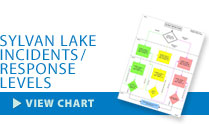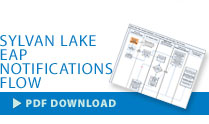Sylvan Lake EAP Case Study
The Engineer's Perspective

Siavash Beik
Siavash Beik previously was chief of the state Division of Water's Dam Safety Program and was one of those who created the state's recommended IEAP template for dam owners to use. He has extensive knowledge of the Indiana trust lakes and dams. In the private sector since 1993, he helped several dam owners develop IEAPs using the template. As leader of the Sylvan Lake Dam team he drafted the IEAP after eliciting input from the various stakeholders participating. He also developed research on the dam's history, construction, capacity, past performance and problems so these could all be addressed in the IEAP.
"We thought this IEAP could be completed in about six months, but by the time it was finished and the tabletop exercise to test it was held, it was about nine months," said Beik. "The most tedious and time-consuming step was the three to four months it took to develop the hydrologic and hydraulic analyses associated with the dam breach inundation study. We had to have this prior to drafting the IEAP.
"Downstream there are inter-connected lakes, some of them natural, and Sylvan Lake contributes about a fifth of the water in the system. Think of this chain of lakes as a river and the lakes are just enlarged portions of the river, surrounded by homes, farms and businesses. This is not like an isolated lake. It meant that our study had to be more elaborate to take all this into consideration. We used what is known as an 'unsteady-state' model of what could happen if Sylvan Lake Dam failed. Once we had the dam breach analysis completed the first draft of the IEAP went very smoothly."
Beik said the IEAP draft process for Sylvan Lake Dam was streamlined.
"Once in the beginning I met with the Conservancy District and others involved," Beik said. "This was followed by a lot of phone calls and emails back and forth, photos shared, reading a lot of background information to see the problems and types of incidents that may come up, defining levels of emergency for various incidents, developing charts, and so on. When the draft was completed it was sent to them for review.
"Then we had a meeting, scheduled the tabletop exercise, and held a full day workshop. The morning was devoted to training, with background information presented, a review of U.S. dam failures to get their attention, then Dams 101 – what they look like and how they work. Some of the public safety officials had no idea what a dam looks like structurally, the terminology, and different types of dams. We went through the IEAP page by page explaining why it is designed the way it is. They were shown the Sylvan Lake Dam's features and components."
In the afternoon, exercises were conducted with different scenarios of dangerous incidents at the dam to illustrate the types of events possible, what each person would need to do, and how it would all time out. There were mock phone calls regarding the events and sometimes unexpected new developments. As a result the notification call-down chart was adjusted to better fit the local system, and other changes were made.
"The IEAP template helps minimize the meetings because everyone can read the template ahead of time and see what we will need to know. That saves time and expense," Beik said. "But then you have to invest in people by teaching them how to carry out the IEAP because they've never done it." The Sylvan Lake IEAP process was more efficient because of the investment of time and attention team members gave in return. When emails were sent around, the people on the team were responsive.
The initial review of the IEAP draft by the core team and other stakeholders sets up opportunities for creative and productive discussion. Questions can be raised, assumptions challenged, changes suggested, and terminology clarified. This may be minimal if the input for the IEAP from various stakeholders was adequate early in the drafting.
"This is a good IEAP in part because it reflects a key message dam owners need to understand: They don't have to notify everybody," Beik said. "That's why the IEAP process involves bringing in the emergency managers and first responders. Once the dam owner gets the message about an incident into the emergency response system, the plan is activated and the notifications and perhaps evacuations are handled by those whose job it is to handle that. The dam owner is relieved of the need to notify anyone else."
The mechanics of how that notification flow will work will vary from one locale to another, but during IEAP development it will be worked out by the various parties involved – the emergency manager, the sheriff, the fire and police departments, and agencies managing shelters, Beik noted. In recent years these agencies have had closer working relationships and more uniform communication systems, but one value of the IEAP process is getting them in the same room to talk about how they would respond to specific set of dam incidents or failure – the roles, the responsibilities, and the protocols.
"The IEAP for Sylvan Lake Dam wound up being more than just a document to everyone," said Beik. "The Conservancy District board feels much more comfortable about their dam, their responsibilities, and their liability toward about 750 homeowners living around the lake and more than 300 homeowners living within the dam breach inundation zone. It is like the IEAP took some major weight off the Conservancy Board's shoulders. They now know that while they are responsible to detect an emergency event at the dam and communicate the severity and consequences of a potential dam failure, the responsibility for warning and evacuation of the downstream population is with the first responders."
A further responsibility that falls on the District and the emergency response community is testing and updating the IEAP.
"We conducted a detailed initial training and tabletop exercise when we first developed the IEAP, and we tweaked the notification procedures as a result of that," said Beik. "Additional updates and tabletop exercises have been happening about every three years, with the next one coming up soon. Based on our encouragement, the emergency first responders also have developed a detailed plan for warning and evacuation of the downstream residents. That is taking place on a parallel and separate schedule. Updates to both plans are sometimes needed when there are changes to one of them.
"An important aspect of dam ownership and Sylvan Lake in particular is that the person dealing with a dam has to be educated about it. Leigh as Town Manager was very much involved when the dam was repaired over the years prior to the IEAP. She also attended dam safety workshops and understood what we were trying to do and its importance for public safety.
"The IEAP process is more difficult when you have the opposite – owners who really have no interest in IEAPs and so don't understand it. They may be participants, but they are not engaged. They do not have the time or are not willing to give you the time they should. Fortunately we had none of that attitude at Sylvan Lake."



